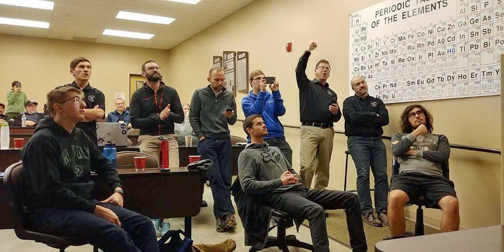
The team of students and faculty from Northwestern Nazarene University celebrate the successful launch of MakerSat-0 on November 18, 2017.
A month has passed since Idaho’s first satellite was launched into space — students at Northwestern Nazarene University are already working on their next smallsat project, according to an infosite article published online in the Idaho Press-Tribune authored by Areena Arora.
The MakerSat-0 satellite was launched into space aboard a Delta II rocket on November 18. The project was envisioned by a team of students and faculty at NNU and also included an experiment developed by students from Caldwell High School. MakerSat is a 4 inch cube with an on-board computer and radio and is gathering and sending information via satellite about the cube’s performance to the students, all part of a mission to test how 3-D printed material will manage in space. The data collected by the satellite will help determine which materials are best suited for future 3D-printed spacecrafts.
“The idea is to completely eliminate the launch process for sending heavy materials to space,” said Connor Nogales, an NNU senior, who worked on the project. “If we can print objects in space, we don’t need to worry about heavy weights during launch process.”
The next satellite that the group is working on, MakerSat-1, is expected to be launched next spring. However, launching a satellite isn’t the end of the project, said Steve Parke, electrical engineering professor who supervised the project. The next goal will be to analyze the data and present it at research conferences, he added.
The new satellite is being designed to be 3-D printed and “snap assembled by an astronaut in zero gravity” on a space station and then deployed from into orbit, according to Parke.
“We hope that it (MakerSat-1) will serve as a role model of how to build satellites and spaceships of the future in space and not on Earth,” Parke said.
Parke said he had been in the field for 35 years and this project was the “highlight” of his career. He called the successful launch “a true Treasure Valley success story.”
Most parts used in the satellite were manufactured locally by Plexus Corporation, an electronics manufacturer, in Nampa, Idaho. MakerSat-0 is orbiting around the Earth’s poles 14 times a day at 17,000 mph, and will be for the next several years, returning data on the robustness of various 3D-printed polymers in the harsh space environment and measuring space radiation levels in the polar auroras.
The project was made possible through funding by the Idaho Space Grant Consortium and partnerships with Made in Space, Near Space Launch, NASA, NanoRacks, and Plexus, according to a press release. MakerSat-0 is one of five CubeSats chosen for NASA’s ELaNa XIV mission on this launch, which was enabled by NASA’s CubeSat Launch Initiative.
To be totally amazed at the technologies, and to engage in highly effective networking with SmallSat subject matter experts, consider attendance at the SmallSat Symposium 2018 that will be conducted at the Computer History Museum in Silicon Valley, California. To learn more, please access http://smallsatshow.com.


